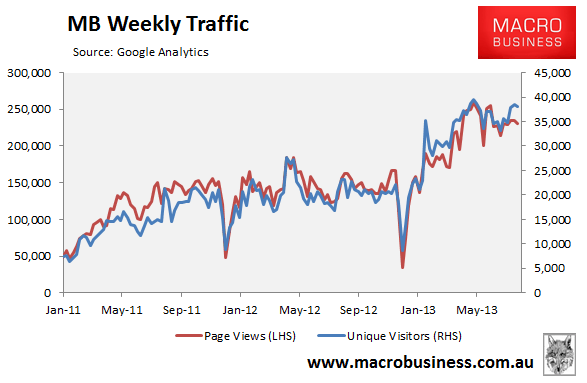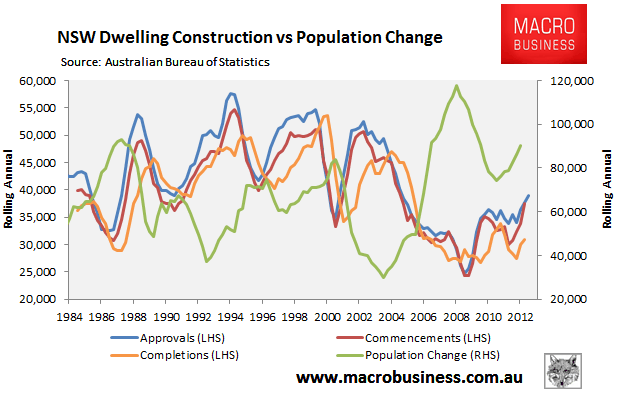
Find below the August Member’s Report in which we continue our detailed look into the prospects for national city housing markets. To subscribe for this and other monthly member reports visit https://www.macrobusiness.com.au/membership/.
——————————————————————————————————-
Sydney’s housing market has sprung to life recently after a prolonged period of underperformance since the second half of the 2000s, which saw its price premium relative to the other capitals falling to levels not seen since the mid-1980s.
There is also compelling evidence to suggest that Sydney housing is built on stronger foundations than most other Australian capitals, and that it still offers better than average value from an investment perspective.
Current State-of-Play:
The evolution of Sydney’s housing market is illustrated by the next chart, which tracks detached house prices, as reported by the four main housing data providers: the Australian Bureau of Statistics (ABS); Australian Property Monitors (APM); RP Data-Rismark; and Residex, as well as a composite measure, which is the average of these indices. Residex has the longest running house price series for Sydney, dating back to the late-1970s, whereas APM’s is relatively new. Despite minor variations, all four series have tracked each other fairly closely (refer to our last Members’ Report for an explanation of how each house price series is constructed).
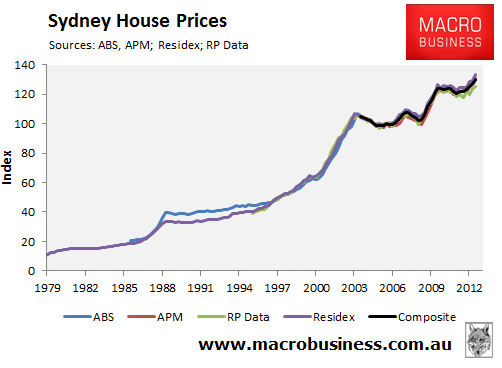
The June quarter price results for Sydney showed the housing market growing at a solid pace. The ABS (6.1%), APM (6.6%), RP Data (6.4%) and Residex (7.4%) all recorded growth in excess of 6% in the year to June 2013, with prices now also 5% above their 2010 peak when averaged out across the four data providers.
The recent price performance of Sydney units has been weaker, with APM (4.9%), RP Data (2.4%) and Residex (2.3%) recording growth under 5% in the year to June 2013, although prices also never experienced the type of declines experienced by detached housing from 2010 (see next chart).
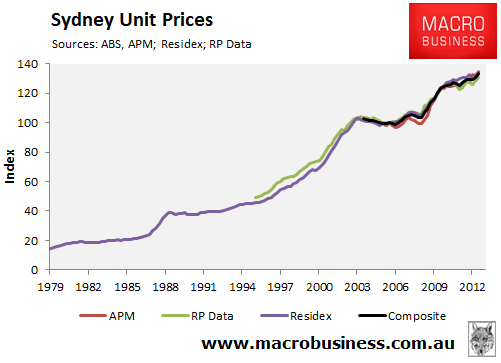
When adjusted for inflation, however, Sydney house prices have performed relatively poorly.
Sydney house prices peaked in real inflation-adjusted terms in late-2003 or early-2004, depending on the series used, and have traded in a sideways range ever since (see next chart).
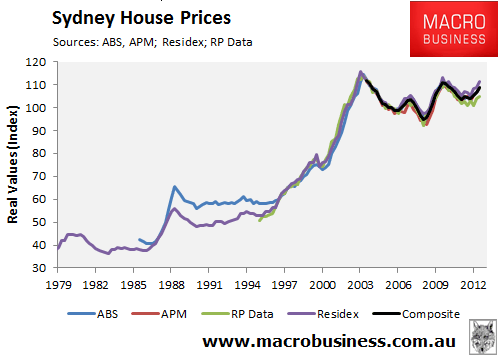
Sydney unit prices have performed a little better in real inflation-adjusted terms, and are now tracking more or less in line with their peak in 2003 or 2004 (see next chart).
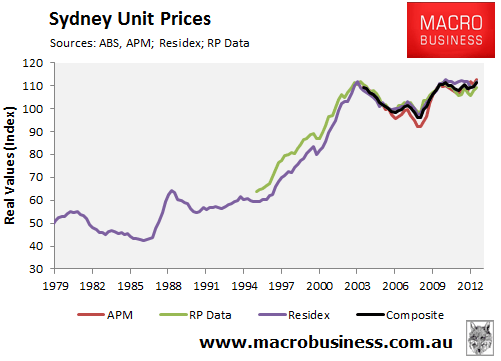
The under-performance of the Sydney housing market has seen its median house price relative to the other capital cities tracking at a level not seen since the mid-1980s, suggesting that Sydney housing still offers relatively good value, despite the more recent price growth (see next chart).
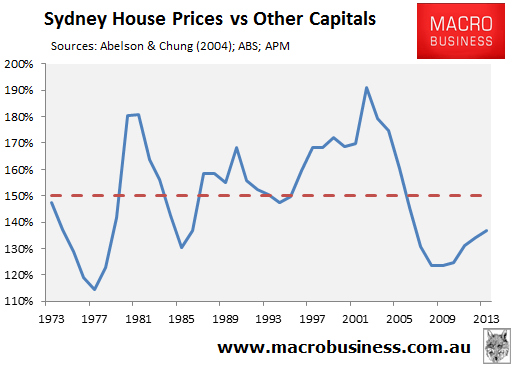
Tight supply continues to support prices:
There are a range of supply-side factors that are supporting Sydney housing values.
First, the construction of new dwellings in New South Wales has fallen over the past decade as its population has grown strongly, suggesting that Sydney is suffering from a bona fide housing shortage (see next chart).
In fact, the rate of construction per 1000 head of population is currently running roughly 50% below the 30-year average, driven primarily by a big fall in detached house construction (see next chart).
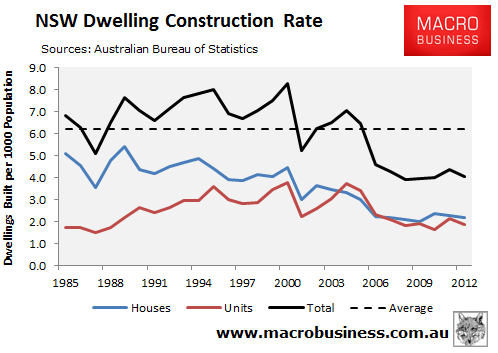
Second, Sydney has around 31% of the nation’s capital city households, yet in July 2013 accounted for only 16% of homes for sale in Australia’s capital cities. Therefore, there also appears to be a shortage of homes for sale in Sydney, with the number having also fallen from the same time last year (see next chart).
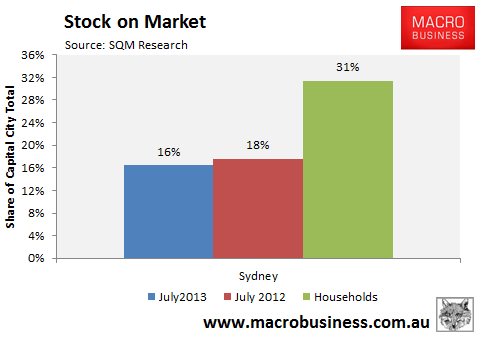
The chronic undersupply of new homes in Sydney has also meant that the rental market has remained relatively tight. Rental vacancy rates in Sydney have, for a number of years, been below the national capital city average (see next chart).
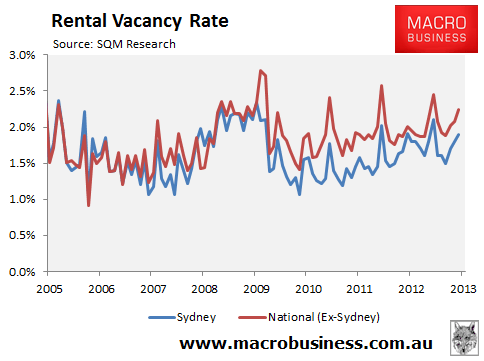
However, despite this lower vacancy rate, Sydney rents have grown only slightly faster than the other capitals, and have more or less flat lined over the past two years (see next chart).
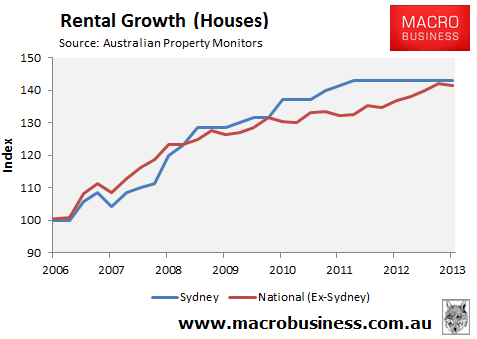
Gross rental yields in Sydney have also slipped just below the other capitals, which largely reflects the stronger price performance of Sydney housing after prices began falling in mid-to-late 2010 (see next chart).
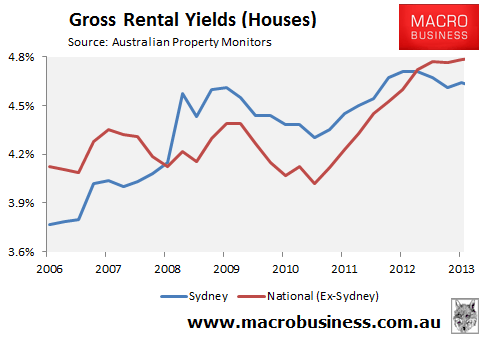
Sydney employment is relatively strong:
Sydney’s employment market has to date held-up relatively well which, if maintained, should support home prices and rents going forward.
New South Wales’ trend unemployment rate is currently 5.6%, which is just below the national average of 5.7% (see next chart).
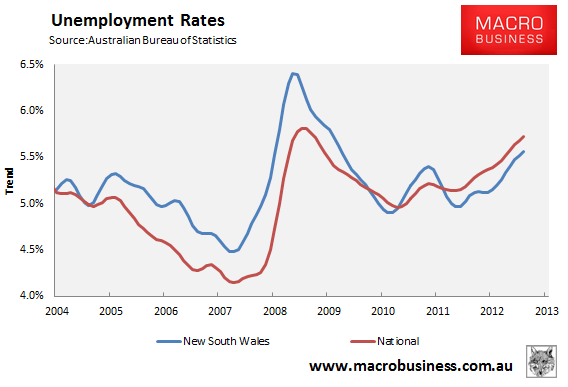
The relative strength of Sydney’s employment market is also evident by the growth in full-time jobs and the aggregate number of hours worked, which have both outperformed the national average over the past year (see below charts).
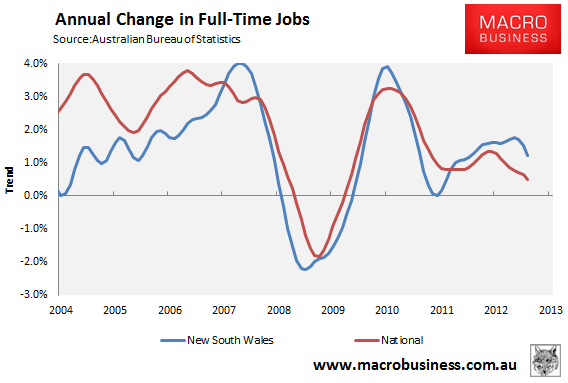
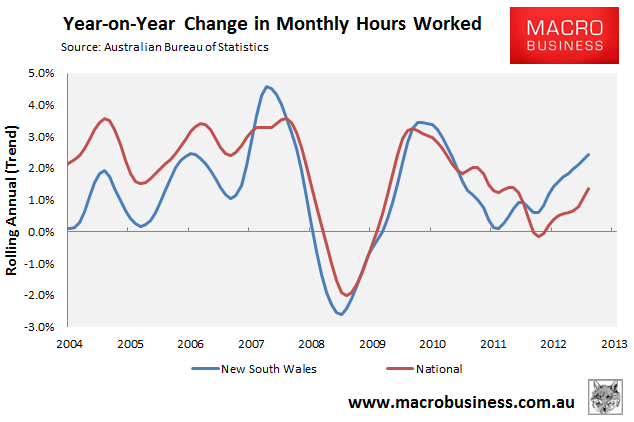
But first home buyers have gone missing:
Mortgage demand has pick-up significantly in New South Wales, with the total number of owner-occupied housing finance commitments (excluding refinancings) increasing by a seasonally-adjusted 13% in the year to June 2013 to be tracking in line with the five-year moving average (see next chart).
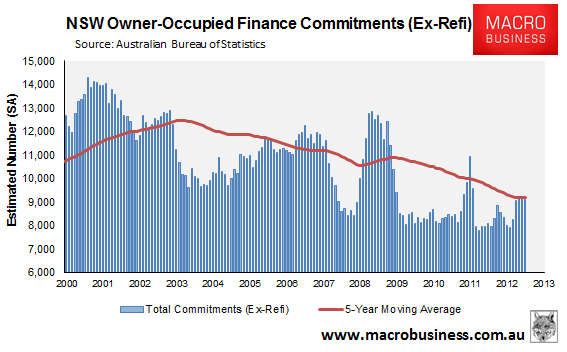
The ABS unfortunately does not break-out investor finance commitments by state. However, these have risen strongly, up by 18% nationally over the past year, with much of this activity likely to have been in Sydney.
One area of concern for Sydney’s housing market is the absence of first home buyers (FHBs). In October 2012, the State Government removed the FHB Grant on pre-existing dwellings, which has led to a sharp drop-off in mortgage demand from this segment.
The number of FHB mortgage commitments fell by 47% in the year to June 2013, and were tracking 64% below the five-year moving average. Further, the share of total finance commitments going to first home buyers was only 7.3% in June 2013, also well below the five-year moving average level of 19.8% (see next chart).
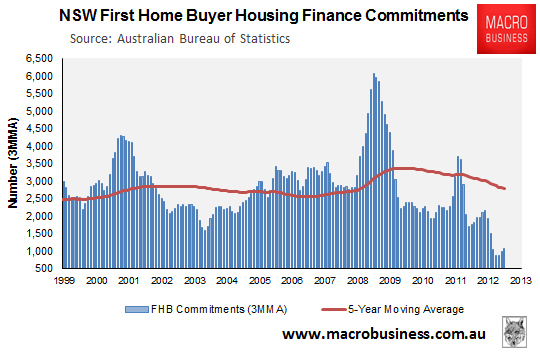
The absence of FHBs is a potential thorn in the rally. In part, it can be explained by the pull forward of demand in 2009/10 as fiscal grants saw an historic surge in the segment. Also, the shifting of those grants to new homes will be playing a role.
Given the fundamentals are sound, the FHB absence hints at the possibility that despite increasing relative value, the surrounding economy is not strong enough to support a strong surge in new market entrants. Either that or some natural affordability ceiling has been reached. This could act as a potential check on the price rally. One possibility is that Sydney continues its last decade of range trading as cheap credit and good fundamentals wrestle with the FHB affordability conundrum.
Regardless, the predomination of investment flows driving price gains means the current price rises can turn more quickly than past cycles if conditions shift.
Bottom Line:
Sydney housing valuations have improved markedly in recent years, with its price premium to the other capitals still at levels not seen since the mid-1980s.
Sydney housing is also built upon relatively strong foundations. Supply is tight, following a decade of declining construction activity and strong population growth. There also appears to be a shortage of homes for sale, and rental vacancy rates remain below the national average.
Sydney’s employment market is also performing relatively well. Unemployment is below the national average, whereas full-time jobs and aggregate hours worked have grown at above average rates, which should help support housing demand, values and rents. One caveat to this is that national incomes will have difficulty rising in the next three years as Australia slogs its way through the post-mining boom adjustment (see our report earlier this month).
For now, mortgage demand appears to be growing strongly in Sydney. However, one area of concern is FHBs. To date, their absence from the market has slowed the rebound in prices when compared with previous rate-cutting cycles. Investors have picked up the slack more aggressively this year as the cash rate fell to record lows; although the situation could easily change in the future.
Overall, Sydney’s superior fundamentals and current momentum should see it continue to outperform the broader housing market in the year ahead, which makes it a safer bet relative to other capital city markets from an investment perspective.
———————————————————————————————————
MB traffic update for August.
